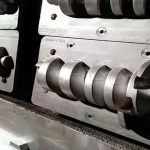Molds or mold parts are damaged. I believe this is something that our friends in the Mold and Materials College will often encounter in mold production. If it’s just a minor problem, but if the core is damaged, it’s not that simple. That will mean that the whole set of mold cores can no longer be used, which will lead to a large amount of mold consumption.
According to a survey, the annual consumption value of molds in the machining industry is five times the total value of various machine tools, and the number is staggering. The impact of large consumption of molds not only increases production costs, but also economic losses caused by low production efficiency due to frequent mold replacement.
Therefore, people in the industry are thinking about whether a new technology can be developed: When the mold is damaged, the damaged area can be directly repaired, so as to avoid unnecessary waste of the mold.
can be done with the help of 3D printing technology.
Repairing damaged mold inserts is a fast-growing field of additive manufacturing (3D printing). Special selective laser melting technology can simplify repairs and reduce downtime by quickly repairing damaged areas instead of replacing damaged tools. Time, extend the service life and reduce costs.
The traditional repair process requires multiple steps and is time-consuming. For example, welding involves cutting off the damaged or worn area, fixing a new steel block, and welding. Additional steps, such as processing, polishing, testing, etc., and such repairs also bring durability problems, which are expensive, time-consuming, and not durable.
3D printing repair mold example
Ecoparts and Innomia have opened up a shortcut for the repair of mold inserts through additive manufacturing. Innomia uses reverse engineering to provide the design and development of plastic and metal parts, three-dimensional scanning and additive manufacturing. Ecoparts is a service provider of EOS, providing prototype manufacturing services, as well as cold mold manufacturing services for the mold and construction machinery industries.
Innomia first entered the field of additive manufacturing due to its involvement in rapid prototyping of metal parts for automobiles, but later, the demand for injection molds including rapid molds and conformal cooling is increasing. Innomia has entered the mold field again, and now, the need for rapid mold repair has become another rapidly growing field.
Through three-dimensional scanning and reverse engineering. This allows the company to repair the damaged mold. Whether there is ready-made 3D data or drawings of the mold is not a limiting factor. They redesigned the complete three-dimensional model by scanning the geometry of the insert. Then, cut or grind the damaged area, because additive manufacturing requires a flat surface, and finally, start the reconstruction process.
3D printing repair parts excellent mechanical properties
According to the accurate three-dimensional geometric model of the damaged area, the repaired three-dimensional model of the part is established. The laser beam path is precisely controlled by the computer-controlled CAD file, which avoids human error. It also ensures a uniform microstructure and no visible welds in the repair insertion area. Post-processing, including milling or polishing, restores the functionality of the insert.
powder bed laser melting technology brings very good mechanical properties of repair parts, for example, MS11.2709 martensitic steel has a hardness of 54 HRC. (Heat treatment can be used for HRC hardness between 34 and 54) In addition, according to the requirements of sintered surface and welding material, different tool steel materials can also be combined. In a closed inert nitrogen environment, an excellent metal structure is formed. This method has been proven to prolong the service life of the mold.
Limitations of 3D printing repair
Ecoparts and Innomia do see the limitations of some powder bed laser melting technology, including the limitation of the build size of additive manufacturing equipment, which cannot be used for the repair of large parts. The equipment they use has a construction surface roughness of about 10Ra, and such parts require regular post-processing.
Link to this article:Damaged mold parts do not need to be replaced by 3D printing to help you repair it as before
Reprint Statement: If there are no special instructions, all articles on this site are original. Please indicate the source for reprinting:Mold Wiki,Thanks!^^

